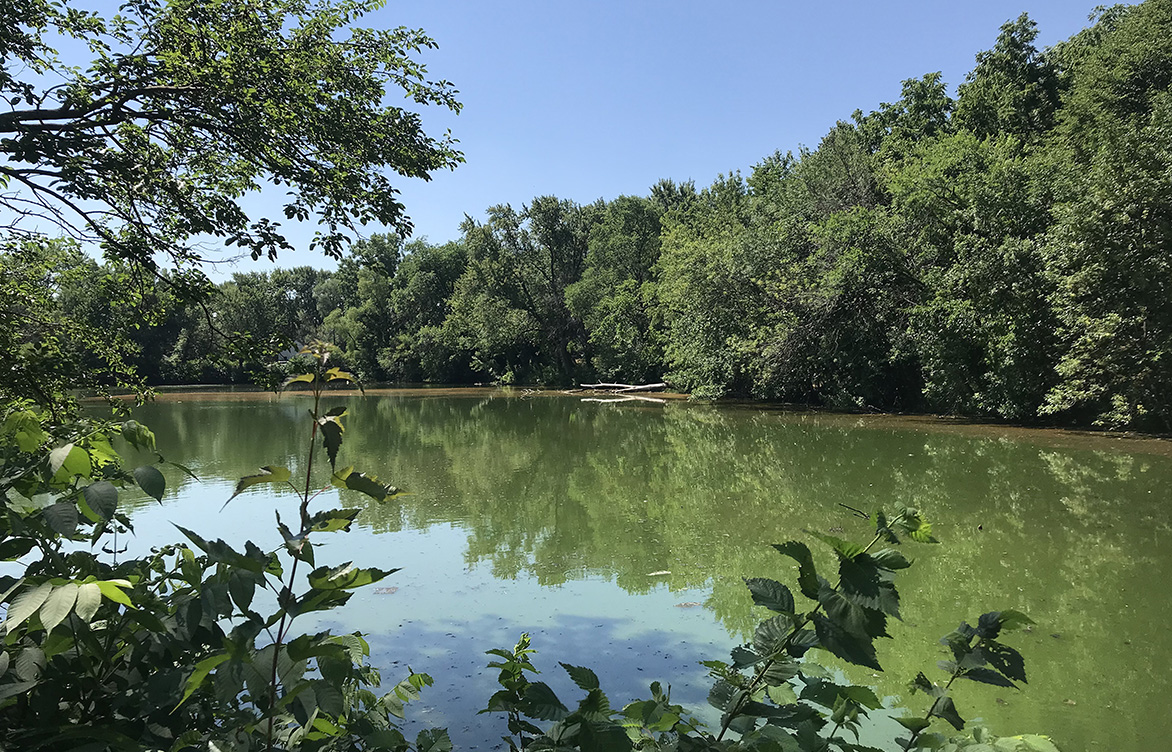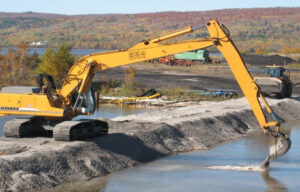 Stormwater ponds were originally intended to improve runoff water quality and mitigate increases in flow rates to downstream water bodies. But do all stormwater pond solutions offer the same benefits?
Stormwater ponds were originally intended to improve runoff water quality and mitigate increases in flow rates to downstream water bodies. But do all stormwater pond solutions offer the same benefits?
Stormwater ponds and wetlands are a key feature in the urban and suburban landscape around the country, with thousands in the outer suburban rings of Minnesota’s Twin Cities area alone. Because they occupy the low point in the watershed and have permanent pools of water, they were originally designed to settle out particles and associated pollutants, serving as an optimal phosphorus sink to prevent nutrient pollution from moving downstream—at least, in theory. But with more comprehensive monitoring data available on these systems, why are we finding that the outflows from some ponds and wetlands have phosphorus concentrations that exceed the inflow concentrations?
When a sink becomes a source
Many of these stormwater ponds that were designed to be “phosphorus sinks” have instead turned into “sources” that actually export nutrients.
In our work supporting many of our clients and with lead researchers in the stormwater field, we are finding that many of these stormwater ponds that were designed to be “phosphorus sinks” have instead turned into “sources” that actually export nutrients. This happens when the phosphorus associated with the accumulated sediments at the bottom of the pond can be released into the water column under certain conditions. The overabundance of these nutrients can lead to eutrophic conditions that can result in harmful algal blooms, which can pose health risks to wildlife, pets, and residents surrounding the ponds and wetlands. Nutrient overabundance can also cause low transparency, poor aesthetics, nuisance floating-leaf plant coverage, and odors. While ponds can be a beautiful feature, when nutrients pile up, the surrounding community can be negatively affected.
Monitoring pond vitality
Oxygen levels are an essential part of the equation when it comes to the health and vitality of a pond and whether it is acting as a source or a sink for phosphorus. Although Nationwide Urban Runoff Program (NURP) design standards intended stormwater ponds to be shallow to avoid stratification and prevent low-oxygen (anoxic) conditions at the bottom, monitoring tells a different story. Despite being shallow, many of these ponds may temporarily stratify, and bottom sediments are becoming anoxic anyway. This is likely due to a combination of factors not fully accounted for in original NURP-era designs, including increased nutrient and organic matter loading from urban runoff, prolonged residence times, warming temperatures, higher chloride concentrations, nuisance floating-leaf plant coverage, rough fish, and aging infrastructure that reduces circulation and mixing. As a result, even shallow ponds can develop low-oxygen zones that compromise their ability to retain phosphorus.
With lower retention abilities, phosphorus is released from the sediments and circulates back into the water column. This trend is consistent across many geographies, and monitoring data suggests that in some stormwater ponds, average phosphorus concentrations can be much higher than initially expected.
Unintended effects downstream
Does that mean these seemingly helpful ponds and wetlands create a potential source for extra nutrients to enter downstream waterbodies? It’s hard to be sure. While some ponds may still be effectively capturing phosphorus, others are now releasing this previously accumulated phosphorus and experiencing harmful algal blooms during the summer months. The gradual overaccumulation and release of phosphorus can prove detrimental to downstream waters, which may be contributing to impairment of some of these resources.

Commitment to smarter solutions
Barr’s ongoing research, monitoring, field investigations, and project work continue to inform strategies for actively managing internal loads within stormwater ponds, wetlands, and lakes. By tailoring our approach to each site, we help clients implement the most effective and sustainable solutions—whether that involves liquid alum or other alternatives mentioned below—to maximize longevity and minimize the need for repeated maintenance.
Alum in dry form
With funding from the Minnesota Stormwater Research Council, we have investigated the long-term effectiveness of alum applications in these various resources. Although alum is typically applied as a liquid and sometimes requires a buffering agent to manage changes in pH, we are actively working on pilot studies to assess alternative forms of alum applications for use in sites where traditional methods aren’t the right fit. For instance, we’re currently evaluating a dry form of alum at a remote site that is difficult to access. While it will take more applications to achieve the appropriate dose, it will ultimately be more cost-effective than the traditional liquid application methods.
Spent lime
Working in partnership with universities, watershed districts, and cities, we have been investigating other treatment agents that could offer more cost savings compared to aluminum sulfate. One of these agents includes spent lime, a calcium carbonate byproduct of the drinking water treatment process. We recently completed two pilot-scale projects that applied spent lime to existing stormwater ponds for two watershed clients, and the results of the initial round of performance monitoring have been promising for both ponds.
Aeration systems
Our lake management experts have been modeling and assessing how aeration systems affect the prevention of anoxic conditions in shallow ponds and lakes. Careful design and long-term maintenance are key—if systems are not appropriately sized, they may fail to prevent anoxia or even worsen water quality by resuspending sediments.
Fall planning can prevent summer surprises
Truly protecting the health of stormwater ponds and other aquatic ecosystems calls for proactive involvement well in advance of the hotter months. Summer is a critical time when warm temperatures and low oxygen levels can trigger phosphorus release from sediments, which turns some of these ponds from a sink to a source. Physically assessing and regularly monitoring phosphorus levels can help catch early signs of nutrient buildup, allowing time to plan for interventions before larger problems arise. Looking beneath the surface allows for smarter, directed actions that work to ensure these ponds continue serving their intended purpose instead of becoming liabilities to downstream resources.
Need help managing high nutrients and harmful algal blooms in your lakes, ponds, and watersheds? Contact our team to start planning your pond management needs for next summer.
About the authors
Katie Turpin-Nagel, senior water resources engineer, has more than 10 years of experience in water resources and environmental engineering. At Barr, she specializes in water quality treatment and management, watershed and in-lake water quality modeling, stormwater planning and management, green infrastructure design, and hydrologic and hydraulic modeling. Katie has completed lake water quality studies for over 30 shallow and deep lakes. She has experience in assessing water quality monitoring data, performing watershed modeling, calibrating zero- and one-dimensional in-lake water quality models, and designing in-lake and watershed best management practices (BMPs). She also has a special interest and technical knowledge related to harmful algal bloom (HAB) analyses and mitigation. Over the past few years, she has presented on HABs at four conferences.
Tyler Olsen, water resources engineer, has eight years of experience with watershed management; surface water quality analysis and modeling; hydrologic and hydraulic modeling; stormwater management and planning; flood risk assessment; and green infrastructure design for public clients, including watershed districts, cities, and counties. He leads projects from the planning stage through construction and operations, maintenance, and monitoring. In addition to providing project management and engineering services, Tyler helps clients strategically implement projects by quantifying benefits such as pollutant reduction, flood risk reduction, and equitable impact. He also supports projects and clients by facilitating public engagement.
Greg Wilson, senior water resources engineer, has more than 35 years of experience in water resources management. His expertise spans lake and watershed management planning, water quality modeling, and hydrology and hydraulics. Greg’s work includes water quality and quantity monitoring and modeling for diagnostic feasibility and TMDL/WRAPS/1W1P/nine-element plan studies for over 100 lakes, including more than 60 shallow lakes and wetlands. He has completed watershed and in-lake water quality modeling, recommended management actions, conducted stormwater research, and facilitated technical advisory group meetings to develop lake management plans. Greg has led design, sediment analysis, and chemical dose determination. He has also explored alternative treatment options for internal phosphorus control for more than 30 lakes and ponds. His research interests include chloride treatment and source control, as well as the use of spent lime to control sediment phosphorus release.
Related projects
Sweeney Lake and Schaper Pond water-quality improvement
Sweeney Lake’s long-running aeration system was found to be contributing to water quality issues rather than resolving them, prompting a comprehensive evaluation and restoration effort. Barr collaborated with the Bassett Creek Watershed Management Commission and the City of Golden Valley to evaluate the aeration system’s impact, develop educational factsheets, and facilitate stakeholder engagement to explore potential solutions. With federal grant funding secured by the commission, Barr and its subcontractors implemented a comprehensive restoration strategy to significantly reduce total phosphorus and improve water quality in Sweeney Lake—efforts that led to the lake’s official removal from Minnesota’s impaired waters list in 2024.
Water quality and ecological improvements to an urban lake
Normandale Lake in Bloomington, Minnesota, faced significant water quality issues due to invasive aquatic plants, internal phosphorus loading, and a large carp population. In response, the Nine Mile Creek Watershed District worked with Barr to implement a holistic lake management program that included drawing down the water to freeze the bottom sediments and kill invasive curly-leaf pondweed, applying alum treatments to prevent sediment phosphorus release, and tracking carp movement for future management. Preliminary results showed a significant reduction in curly-leaf pondweed, and the lake was restocked with fish to help restore ecological balance.








